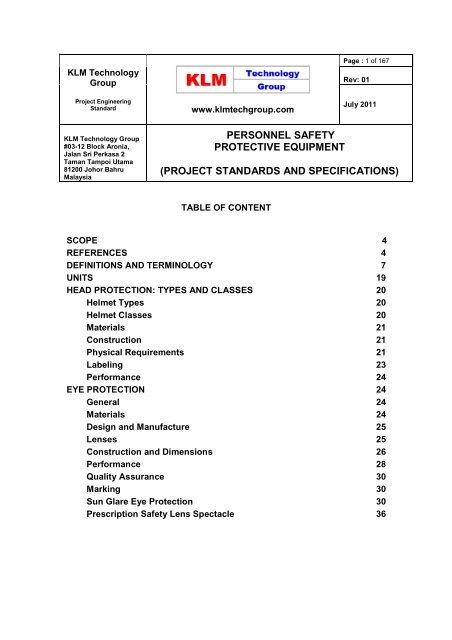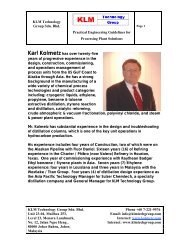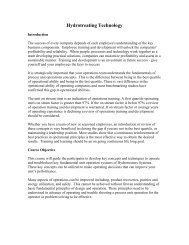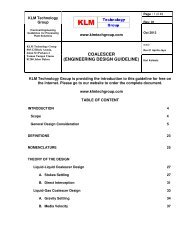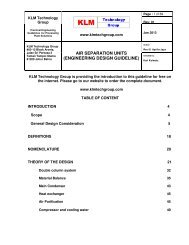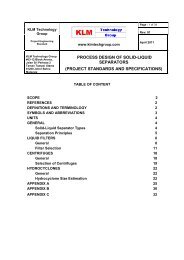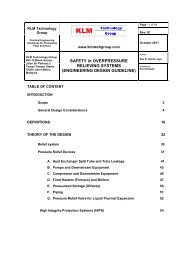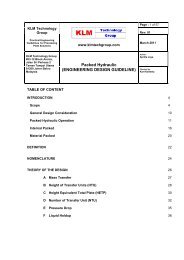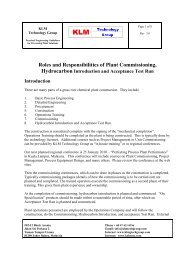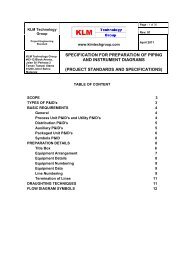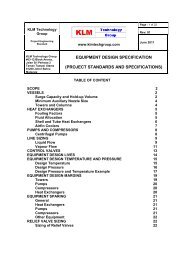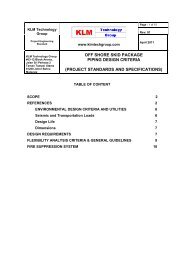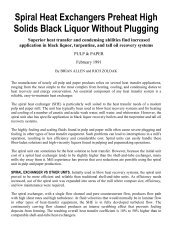586. Engineering Standards for Personnel Protective Equipment ...
586. Engineering Standards for Personnel Protective Equipment ...
586. Engineering Standards for Personnel Protective Equipment ...
Create successful ePaper yourself
Turn your PDF publications into a flip-book with our unique Google optimized e-Paper software.
KLM TechnologyGroupPage : 1 of 167Rev: 01Project <strong>Engineering</strong>Standardwww.klmtechgroup.comJuly 2011KLM Technology Group#03-12 Block Aronia,Jalan Sri Perkasa 2Taman Tampoi Utama81200 Johor BahruMalaysiaPERSONNEL SAFETYPROTECTIVE EQUIPMENT(PROJECT STANDARDS AND SPECIFICATIONS)TABLE OF CONTENTSCOPE 4REFERENCES 4DEFINITIONS AND TERMINOLOGY 7UNITS 19HEAD PROTECTION: TYPES AND CLASSES 20Helmet Types 20Helmet Classes 20Materials 21Construction 21Physical Requirements 21Labeling 23Per<strong>for</strong>mance 24EYE PROTECTION 24General 24Materials 24Design and Manufacture 25Lenses 25Construction and Dimensions 26Per<strong>for</strong>mance 28Quality Assurance 30Marking 30Sun Glare Eye Protection 30Prescription Safety Lens Spectacle 36
KLM TechnologyGroupProject <strong>Engineering</strong> StandardPERSONNEL SAFETYPROTECTIVE EQUIPMENT(PROJECT STANDARDS ANDSPECIFICATIONS)Page 2 of 167Rev: 01July 2011FACE PROTECTION: REQUIREMENTS FOR EYE, FACEAND NECK SHIELD PROTECTION 38General 38Classification of Protection Requirements 38Optical Quality 39Protection Against Radiation 39Design and Manufacture 39Faceshields and Helmets 41Size of Filter Holder and Filters 42Marking 44Disinfection 44Tests 44HAND PROTECTION 44General 44Materials 49Construction and Design 50PVC Gloves (Types 6 to 11 of Table 5) 55Rubber Gloves (Types 12 to 15 of Tables 5 and 17) 58Per<strong>for</strong>mance Requirement 59Marking 60Rubber Gloves <strong>for</strong> Electrical Purposes 60<strong>Protective</strong> Leather Gloves <strong>for</strong> Welders 66EAR PROTECTION 70General 70General 70Per<strong>for</strong>mance Tests 74Test Result 74In<strong>for</strong>mation 75Marking 75Ear Plugs 76Sonic Ear Valve 78Marking 79
KLM TechnologyGroupProject <strong>Engineering</strong> StandardPERSONNEL SAFETYPROTECTIVE EQUIPMENT(PROJECT STANDARDS ANDSPECIFICATIONS)Page 3 of 167Rev: 01July 2011FOOT PROTECTION 79General 79General Requirements 80Conductive Safety Footwear 85Electrical Hazard Footwear 87Per<strong>for</strong>mance Requirements 89Marking 90Labeling 92BODY PROTECTION 93General 93Specification <strong>for</strong> General Industrial Workwear 93<strong>Protective</strong> Apron <strong>for</strong> Wetwork 98High Visibility Garments and Accessories 100CHEMICAL PROTECTIVE CLOTHING 101General 101Materials 102Types and Construction 105Use and Maintenance 114Sizing of Jackets, Coats, Overtrousers and One-Piece Suits 118Instructions and Marking 119Examples 122APPENDIX A 123APPENDIX B 134APPENDIX C 143APPENDIX D 146APPENDIX E 149APPENDIX F 151APPENDIX G 156APPENDIX H 159APPENDIX I 160APPENDIX J 165APPENDIX K 166APPENDIX L 167
KLM TechnologyGroupProject <strong>Engineering</strong> StandardPERSONNEL SAFETYPROTECTIVE EQUIPMENT(PROJECT STANDARDS ANDSPECIFICATIONS)Page 4 of 167Rev: 01July 2011SCOPEThis Project Standard and Specification specifies the minimum requirements <strong>for</strong>types, classes, materials, design, physical and per<strong>for</strong>mance that af<strong>for</strong>d protectionto all body members of the wearer in industrial plants. It is <strong>for</strong>med to cover aseparate section <strong>for</strong> each group of protective clothing.REFERENCESThroughout this Standard the following dated and undated standards/codes arereferred to. These referenced documents shall, to the extent specified herein,<strong>for</strong>m a part of this standard. For dated references, the edition cited applies. Theapplicability of changes in dated references that occur after the cited date shallbe mutually agreed upon by the Company and the Vendor. For undatedreferences, the latest edition of the referenced documents (including anysupplements and amendments) applies.1. ANSI (AMERICAN NATIONAL STANDARDS INSTITUTE)ANSI 89.1 (1986) "<strong>Protective</strong> Headwear <strong>for</strong> Industrial WorkersRequirements"ANSI Z41.1 (1986) "<strong>Personnel</strong> <strong>Protective</strong> Footwear"2. BSI (BRITISH STANDARDS INSTITUTION)BS 5240 (1987)Part 1BS 6489BS 679 (1977)B S 1542 (1982)BS 2092 (1987)BS 2724 (1987)BS 2738 (1989)"Industrial Safety Helmets""Specification <strong>for</strong> Construction and Per<strong>for</strong>mance""Head<strong>for</strong>ms <strong>for</strong> Use in the Testing of <strong>Protective</strong> Helmets""Specification <strong>for</strong> Filters <strong>for</strong> Use During Welding andSimilar Industrial Operations""<strong>Equipment</strong> <strong>for</strong> Face and Neck Protection Against NonIonizing Radiation Arising During Welding and SimilarOperations""Eye Protectors <strong>for</strong> Industrial and Non Industrial Uses""Sun Glare Eye Protectors <strong>for</strong> General Use""P.2 Spectacle Lenses""Specification <strong>for</strong> Tolerances on Optical Properties ofUncut Finished Lenses"BS 3199 (1972) "Method <strong>for</strong> Measurement of Spectacles Including aGlossary of Terms"BS 903 "Method of Testing Vulcanized Rubber Part A2.Determination of Tensile Stress-Strain Properties. Part A19 Heat Resistance and Accelerated Air Aging Tests. Part
KLM TechnologyGroupProject <strong>Engineering</strong> StandardPERSONNEL SAFETYPROTECTIVE EQUIPMENT(PROJECT STANDARDS ANDSPECIFICATIONS)Page 5 of 167Rev: 01July 2011A 38 Determination of Dimensions of Test Pieces andProducts <strong>for</strong> Test Purposes"BS 1651 (1986) "For Industrial Gloves"BS 2471 (1984) "Methods of Test <strong>for</strong> Textiles-Woven Fabrics-Determination of Mass"BS 3144 "Methods of Sampling and Physical Testing of Leather"BS 5108 (1982) "Method <strong>for</strong> Measurement of Sound Attenuation of HearingProtectors"(ISO 4869: 1981)BS 6344 (1988) "Industrial Hearing Protectors"(Parts 1 and 2)BS 5145 (1989) "Lined Industrial Vulcanized Rubber Boots"BS 5451 (1977) "Electrically Conducting and Antistatic Rubber Footwear"BS 2576 (1986) "Method <strong>for</strong> Determination of Breaking Strength andElongation (Strip Method) of Woven Fabrics"BS 3870 "Stitches and Seams"BS 3870 "Classification and Terminology of Stitch Types"Part (1) (1991)BS 3870 "Classification and Terminology of Seam Types"Part (2) (1991)BS 6629 (1985) "Specification <strong>for</strong> Optical Per<strong>for</strong>mance of High VisibilityGarments and Accessories <strong>for</strong> Use on the Highway"BS 903 (1987) "Methods of Testing Vulcanized Rubber"Part A-16 "Determination of the Effects of Liquids"BS 2576 "Method <strong>for</strong> Determination of Breaking Strength andElongation (Strip Method) of Woven Fabrics"BS 3084 (1981) "Specification <strong>for</strong> Solid Fasteners"BS 3424 "Testing Coated Fabrics"Part 7, Method 9 "Method <strong>for</strong> Determination of Coating Adhesion Strength"BS 3546 "Coated Fabrics <strong>for</strong> Water Resistant Clothing"Part 1: "Specification <strong>for</strong> Polyurethane and Silicone ElastomerCoated Fabrics"Part 2: "Specification <strong>for</strong> PVC Coated Fabrics"Part 3: "Specification <strong>for</strong> Natural Rubber and Synthetic RubberPolymer Coated Fabrics"BS 4724 (1986) "Resistance of Clothing Materials to Permeation byLiquids"Part 1 (1986) "Method <strong>for</strong> the Assessment of Breakthrough Time"Part 2 (1988) "Method <strong>for</strong> the Determination of Liquid Permeatingafter Breakthrough"
KLM TechnologyGroupProject <strong>Engineering</strong> StandardPERSONNEL SAFETYPROTECTIVE EQUIPMENT(PROJECT STANDARDS ANDSPECIFICATIONS)Page 6 of 167Rev: 01July 2011BS 5438BS 6249Part 1:BS 2092 (1987)"Methods of Test <strong>for</strong> Flammability of Vertically OrientedTextile Fabrics Assemblies Subjected to a Small IgnitingFlame""Materials and Material Assemblies Used in Clothing <strong>for</strong>Protection Against Heat and Flame""Specification <strong>for</strong> Flammability Testing and Per<strong>for</strong>mance""Specification <strong>for</strong> Eye Protectors <strong>for</strong> Industrial and Non-Industrial Uses"BS 2723 (1988) "Specification <strong>for</strong> Firements Leather Boots"BS 5145 (1984) "Specification <strong>for</strong> Lined Industrial Vulcanized RubberBoots"3. ISO (INTERNATIONAL ORGANIZATION FOR STANDARDIZATION)ISO 4850 (1979) "Personal Eye-Protectors <strong>for</strong> Welding and RelatedTechniques Filter-Utilization and TransmittanceRequirement"ISO 4851 (1979) "Personal Eye Protectors-Ultra-Violet Filters-Utilization andTransmittance Requirement"ISO 4852 (1978) "Personal Eye Protectors-Infra-Red Utilization andTransmittance Requirement"ISO 4855 (1981) "Personal Eye Protectors-Non Optical Test Methods"ISO 2251 (1975) EISO 6530 (1990)"Lined Antistatic Rubber Footwear""<strong>Protective</strong> Clothing-Protection Against Liquid Chemical-Determination of Resistance of Materials to Penetration byLiquids"4. JIS (JAPANESE STANDARD INSTITUTE)JIS T 8103 (1983) “Anti-Electrostatic Footwears With/Without SafetyToes"JIS S 50375. ASTM (AMERICAN STANDARD FOR TEST OF MATERIAL)ASTM D 2582-67 "Standard Test Method <strong>for</strong> Puncture Propagation TearResistance of Plastic (1984) Films and Thin Sheeting"6. NFPA (NATIONAL FIRE PROTECTION ASSOCIATION)1971(2000) "Standard on <strong>Protective</strong> Ensemble <strong>for</strong> Structural FireFighting"1975(2005) "Standard on Station/Work Uni<strong>for</strong>m Fire and EmergencyServices"
KLM TechnologyGroupProject <strong>Engineering</strong> StandardPERSONNEL SAFETYPROTECTIVE EQUIPMENT(PROJECT STANDARDS ANDSPECIFICATIONS)Page 7 of 167Rev: 01July 2011DEFINITIONS AND TERMINOLOGYHead ProtectionBrim - An integral part of the shell extending outward over the entirecircumference.Chin strap - An adjustable strap that fits under the chin to secure the helmet tothe head.Crown straps - The part of the suspension that passes over the head.Harness - The complete assembly by means of which the helmet is maintainedin position on the wearer’s head.Headband - The part of the harness that encircles the head.Helmet - A device that is worn to provide protection <strong>for</strong> the head, or portionsthereof, against impact, flying particles, electric shock, or any combinationthereof; and that includes a suitable harness.Nape strap - A strap that fits behind the head to secure the helmet to the head; itmay be an integral part of the headband.Peak - An integral part of the shell extending <strong>for</strong>ward over the eyes only.<strong>Protective</strong> padding - A material used to absorb the kinetic energy of impact.Shell - A helmet without its harness, accessories, and fittings.Suspension - The portion of the harness that is designed to act as an energyabsorbingmechanism. It may consist of crown straps, protective padding, or asimilar mechanism.Sweatband - The part of the headband, whether integral or replaceable, thatcomes in contact with at least the wearer’s <strong>for</strong>ehead.Winter liner - A sung-fitting cover worn under the helmet to protect the head,ears, and neck from cold.Eye Protection and Face Protection
KLM TechnologyGroupProject <strong>Engineering</strong> StandardPERSONNEL SAFETYPROTECTIVE EQUIPMENT(PROJECT STANDARDS ANDSPECIFICATIONS)Page 8 of 167Rev: 01July 2011Backing lens - A transparent plate used between the eye and the welding filter.Note: The terms’ chipping lens’ and ’rear cover plate’ are also used in practice.Basic eye-Protector - An eye-protector that satisfies the minimum requirements,but does not give the additional protection detailed in the following 5 Clauses:- Impact eye-protectorAn eye-protector able to withstand the impact test to grade 1 or grade 2 andproviding lateral protection to the orbital cavities. Grade 1 impact eyeprotectorsare able to withstand a velocity of impact of 120 m/s, and grade 2are able to withstand 45 m/s.- Molten metals eye-protectorAn eye-protector that provides protection against molten metal splash and hotsolids.- Gases eye-protectorAn eye-protector that provides protection against gases and vapors.- Dusts eye-protectorAn eye-protector that provides protection against dusts.- Liquids eye-protectorAn eye-protector that provides protection against splashes or droplets ofliquids.Cover lens - A transparent cover used in front of the welding filter as a protectionagainst welding splatter, etc.Note: The terms ’filter cover’ and ’cover plate’ are also used in practice.Dark shade - Shade number corresponding to the minimum value of luminoustransmittance ôd. (see BS. 679).Dual shade filter - A type of welding filter, part of which is made in a lightershade and allows the welder to set up the work with a helmet or headshield inposition be<strong>for</strong>e starting the welding operation; during welding the welder viewsthe process through the darker part of the filter.Eye-protector - Any <strong>for</strong>m of eye-protective equipment covering at least theregion of the eyes.Face screen - An eye-protector covering all or a substantial part of the face.Note: Also known as ’face shield’ or ’visor’.
KLM TechnologyGroupProject <strong>Engineering</strong> StandardPERSONNEL SAFETYPROTECTIVE EQUIPMENT(PROJECT STANDARDS ANDSPECIFICATIONS)Page 9 of 167Rev: 01July 2011Face shield - A device worn in front of the face to give protection to the eyes,face and throat. It is either made of the material of the filter itself or is fitted withthe filter(s) and, when provided, the filter cover(s).Filter - The part of an eye protector through which a wearer sees and that isdesigned to reduce the intensity of incident radiation.Goggles - An eye-protector fitted with a single or two separate oculars enclosingthe orbital cavities.Gradient filter - A filter used in sun glare spectacle in which luminoustransmittance changes progressively in the vertical meridian, when the filter ismounted, over some or all of the filter.Hand shield - A device held in the hand to give protection to the eyes, face andthroat. It is fitted with filter(s) and, where provided, filter cover(s).Helmet - A device supported on the head to give protection to the face, ears andthroat and part of the top of the head. It is fitted with filter(s) and, where provided,filter cover(s).Housing - The part of the equipment that supports the filter(s), filter cover(s) andbacking lens.Light shade - Shade number corresponding to the maximum value of luminoustransmittance ôL. (see BS 679).Liquid droplets - Very small mass particles or a liquid substance capable ofremaining in suspension in gas.Neck shield - An article of protective clothing that, when fitted to a helmet,af<strong>for</strong>ds protection from reflected radiation to the back and sides of the head andneck.Note: The design may include an extension to cover the lower part of the throat.Ocular - The transparent part of the eye-protector that permits vision, <strong>for</strong>example, lens, visor, screen.Orbital cavities - The apertures in the skull in which the eyes and theirappendages sit.
KLM TechnologyGroupProject <strong>Engineering</strong> StandardPERSONNEL SAFETYPROTECTIVE EQUIPMENT(PROJECT STANDARDS ANDSPECIFICATIONS)Page 10 of 167Rev: 01July 2011Photochromic Filter - A filter used on sun glare spectacle that reversibly alter itsluminous transmittance under the influence of sunlight.Polarizing filter - A filter used on sun glare spectacle in which the transmittanceis dependent on the amount and orientation of the polarization of the incidentradiation.Spectacles - An eye-protector, the oculars of which are mounted in a spectacletypeframe, with or without side shields. Mounted oculars include lenses integralwith the frame.Welding goggles - Is a device enclosing 3 space in front of the eyes into whichradiation arising from welding can penetrate only through filter(s) and, whereprovided, filter cover(s).Note: Goggles are usually held in position by a headband.Variable shade Filter - A filter in which the transmittance varies in response tothe incident light intensity, so enabling the user to set work with the filter inposition and with a satisfactory view; on striking the arc the luminoustransmittance decreases and the device acts as a conventional welding filter. Theprocess reverses when welding stops.Note: The variable transmittance is usually achieved by means of an integralelectronic circuit with a built-in power supply.Variable shade window - A device that enables observation of the workpiecebe<strong>for</strong>e the welding arc is ignited and that automatically changes its shadenumber from a light shade to a dark shade when the welding arc is ignited.Note: A variable shade window is used only in combination with a welding filterwhich complies with this Standard.Hand ProtectionClute patterns - A four-finger and thumb design, having one-piece palm,including the fronts of all four fingers and a separate cuff [see Fig. 1(a)]. Theback comprises three of four separate pieces of material.Cuff - The extension on a glove or mitt which covers the wrist (examples areshown in Fig. 2).Flock lined (rubber or PVC) gloves - Gloves which have their inner surfacecovered in a layer of pure cotton fibers, anchored into the rubber of PVC duringmanufacture. These absorb perspiration and help to keep the hands cool during
KLM TechnologyGroupProject <strong>Engineering</strong> StandardPERSONNEL SAFETYPROTECTIVE EQUIPMENT(PROJECT STANDARDS ANDSPECIFICATIONS)Page 11 of 167Rev: 01July 2011use in a warm environment; conversely, they contribute to warmth when used ina cold application.Gauntlet - A type of glove which, relative to the wrist glove, provides additionalprotection <strong>for</strong> the wrist and part of or the whole of the arm.Gunn pattern - A four-finger and thumb design, having the face of the thumb,the palm, and first (index) and fourth (little) fingers made of one or two pieces ofmaterial. The back is of one piece up to the cuff and includes the back of the fourfingers at least. The fronts of the second and third fingers may be one pieceeach, jointed to the palm at the base of the appropriate fingers [see Fig. 1(b)].The back of the glove may be jointed.Mitt - A covering <strong>for</strong> the hand and wrist, having a separate thumb and a commoncovering <strong>for</strong> the fingers.Montpelier pattern - A four-finger and thumb design, having the palm and thefronts of all four fingers in one piece, and the back of the glove and the backs ofall four fingers in one piece. This pattern has a fourchette between the fingers(see Fig. 1(c)).One-Finger mitt - A covering <strong>for</strong> the hand and wrist, having a separate thumband <strong>for</strong>efinger and a common covering <strong>for</strong> the remaining fingers.Wrist glove - A wrist length glove providing covering <strong>for</strong> the hand and wrist,having separate fingers.Wristing - Additional fitment attached to the main body of the glove at the opencuff end to present a close fit to the wrist of the wearer.
KLM TechnologyGroupProject <strong>Engineering</strong> StandardPERSONNEL SAFETYPROTECTIVE EQUIPMENT(PROJECT STANDARDS ANDSPECIFICATIONS)Page 12 of 167Rev: 01July 2011Basic PatternsFig. 1 - Glove PatternsFig. 2 - Cuff Patterns
KLM TechnologyGroupProject <strong>Engineering</strong> StandardPERSONNEL SAFETYPROTECTIVE EQUIPMENT(PROJECT STANDARDS ANDSPECIFICATIONS)Page 13 of 167Rev: 01July 2011Ear ProtectionAcoustic Test Fixture (ATF) - A device that approximates certain dimensions ofan average adult human head and is used <strong>for</strong> measuring the insertion loss of earmuffs. For this purpose it includes a microphone arrangement <strong>for</strong> measuringsound pressure levels.Attenuation - The algebraic difference in dB between the 1/3 octave bandpressure level, as perceived by a real ear at threshold in a specified sound fieldunder specified conditions, with the hearing protector absent and the soundpressure level with the hearing protector being worn, with other conditionsidentical.Cup - A hollow, approximately hemispherically shaped component which ismounted on the headband and to which a cushion and a liner are usually fitted.Note: In this context, a cup is sometimes referred to as a shell.Cushion - A de<strong>for</strong>mable cover, usually foam plastics or liquid filled, fitted to therim of the cup to improve the com<strong>for</strong>t and fit of the ear muffs on the head.Note: In this context, a cushion is sometimes referred to as a seal.Decibel (dB) - One-tenth of a bel, a scale unit used in comparison of themagnitude of powers. The number of bels, expressing the relative magnitudes oftwo powers, is the logarithm to the base 10 of the ratio of the powers.Ear Muffs - A hearing protector, either fitting over and enclosing the pinna andsealing against the side of the head (circumaural) or sealing against the pinna(supraaural). Over-the-head, and ear muffs are designed to be worn with theheadband passing over the top of the head and behind the head respectively. Ahead strap supports behind-the head ear muffs by being in contact with the top ofthe head. Universal ear muffs can be worn in either mode.Ear Plugs - A hearing protector inserted and worn in the ear canal or in the earcavity.- DisposableIntended <strong>for</strong> one fitting only.- ReusableIntended <strong>for</strong> more than one fitting.- Sonic ear plugInsert tipe ear protector utilizing a moving diaphragm, that attenuate harmfulhigh level noises without blocking normal background sound.
KLM TechnologyGroupProject <strong>Engineering</strong> StandardPERSONNEL SAFETYPROTECTIVE EQUIPMENT(PROJECT STANDARDS ANDSPECIFICATIONS)Page 14 of 167Rev: 01July 2011Head band - A band, usually of metal or plastics, designed to enable the earmuffs to fit securely around the ears by exerting pressure through the cushions.Head strap - A flexible strap fitted to each cup, or the headband close to the cup.It can be adjusted to support the ear muffs, usually behind-the-head types, byfitting closely to the top of the head.Helmet - A device covering a substantial part of the head and generally havingfunctions other than, or in addition to, hearing protection.Head width - Maximum width of head when subject is sitting erect (see Fig. 3).Head height - Vertical distance between tragus and top of head when subject issitting erect (see Fig. 3).Head depth - Horizontal distance between tragus and vertical line through backof head when subject is sitting erect (see Fig. 3).Insertion loss - The algebraic difference in dB between the 1/3 octave bandpressure level, measured by the microphone of the acoustic test fixture in aspecified sound field under specified conditions, with the hearing protectorabsent and the sound pressure level with the hearing protector on, with otherconditions identical.Liner - Material contained within the cup which can increase the attenuation ofthe ear muffs at certain frequencies.Pin noise - Noise whose sound pressure spectral density is inverselyproportional to frequency, i.e., equal energy in each 1/3 octave band.


